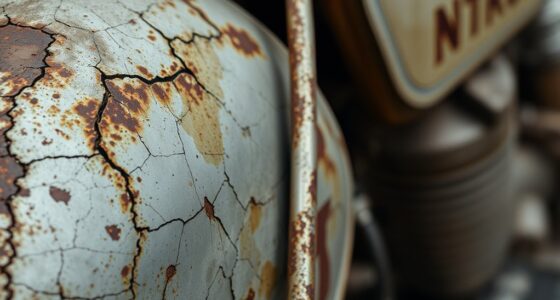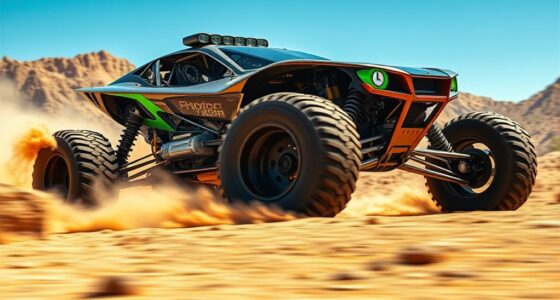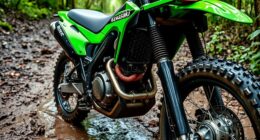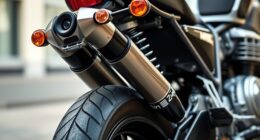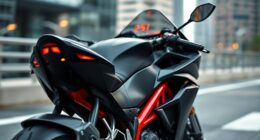On the trails, your Indian Scout’s torque delivers immediate power, helping you start smooth and navigate tough sections like rocks and mud with better control. Horsepower, meanwhile, maintains your momentum going over long stretches and boosts speed when needed. Balancing both guarantees you can handle technical parts without losing speed. Understanding how torque and horsepower work together lets you optimize your ride for better performance and enjoyment—continue exploring to master your trail adventures.
Key Takeaways
- Torque provides immediate low-end power essential for technical trail sections and steep climbs.
- Horsepower maintains speed and momentum over longer stretches and open trail segments.
- The Indian Scout balances torque and horsepower for optimal control and trail performance.
- Adequate torque enhances low-speed handling, while horsepower supports acceleration and sustained riding.
- Understanding this balance helps riders navigate trails more effectively and efficiently.

When tackling trails on your Indian Scout, understanding how torque and horsepower influence your ride can make a big difference. These two factors are key to engine performance, which directly impacts your ability to navigate challenging terrain and maintain rider control. Torque provides the immediate power needed to start moving and climb steep inclines, while horsepower determines how well the bike sustains speed and handles longer stretches of trail. Recognizing how each plays a role helps you optimize your riding style and make smarter decisions on tough trails.
Understanding torque and horsepower helps you optimize your Indian Scout’s trail performance and rider control.
Torque is all about raw pulling power. When you twist the throttle, it’s torque that gets the wheels turning from a standstill or when you’re climbing over rocks and roots. It’s especially *vital* in off-road situations where low-end power can mean the difference between easily powering through mud or getting stuck. The Indian Scout’s torque curve is designed to deliver strong low- and mid-range power, giving you the confidence to control the bike precisely during technical sections. This immediate response helps you keep your footing and maintain stability, which is essential for rider control on uneven terrain. With ample torque, you can modulate your throttle to match trail conditions without feeling overwhelmed, ensuring smoother navigation through complex sections.
Additionally, engine efficiency plays a crucial role in how effectively your bike performs over the course of a ride, especially on demanding trails.
Horsepower, on the other hand, comes into play once you’re already moving and need sustained power to keep up momentum. It’s what allows your Indian Scout to maintain higher speeds once you’ve gained initial traction. On trails, horsepower helps you accelerate out of corners, power through open stretches, and handle long climbs without losing speed. It also influences how the bike responds when you’re pushing at the limits, giving you that extra edge for speed and efficiency. A higher horsepower engine enables you to stretch your rides farther and tackle more demanding trails, but it’s equally important to have enough torque to get you rolling and maintain control in tricky spots.
Balancing torque and horsepower is key to maximizing engine performance and rider control. Too much torque without enough horsepower can make your bike feel twitchy or difficult to manage at higher speeds, while too much horsepower with insufficient torque might leave you struggling to get moving or control the bike at low speeds. The Indian Scout’s engine is designed to strike this balance, offering enough low-end torque to handle technical sections while providing sufficient horsepower to keep your momentum on longer trail segments. Understanding this interplay allows you to adapt your riding techniques—using torque for precise control in tight spots, and leveraging horsepower for sustained speed—making your trail rides more enjoyable and less stressful.
Frequently Asked Questions
How Does Terrain Affect Torque and Horsepower Performance?
Terrain directly impacts your bike’s torque and horsepower performance. On rugged trails, high torque helps you tackle steep inclines and rough surfaces, while horsepower maintains steady speed on open stretches. Terrain adaptability guarantees you get the right power when needed, and it can also influence fuel efficiency—more demanding terrains may drain your fuel faster. Understanding this balance helps you optimize your ride for trail conditions and enjoy smoother handling.
What Maintenance Impacts Torque and Horsepower Over Time?
Did you know that neglecting engine cooling can reduce your bike’s torque and horsepower by up to 15%? Over time, poor maintenance affects engine performance, lowering fuel efficiency and power output. Regularly check and clean cooling systems, change oil, and maintain proper fuel levels. Keeping your engine in top shape guarantees consistent torque and horsepower, helping you tackle trails confidently and enjoy maximum performance every ride.
Can Modifications Improve Indian Scout’s Torque or Horsepower?
Yes, you can improve your Indian Scout’s torque and horsepower with modifications like aftermarket exhausts and air intake upgrades. Installing a performance exhaust reduces backpressure, boosting power, while upgrading the air intake allows more air to reach the engine, increasing efficiency. These modifications work together to enhance your bike’s overall performance, making it more responsive and powerful on trails. Just make certain you choose quality parts and get proper tuning for the best results.
How Do Rider Weight and Luggage Influence Power Output?
Rider weight and luggage can slightly decrease your Indian Scout’s power output, affecting fuel efficiency and rider experience. Heavier loads demand more engine effort, which may lead to reduced acceleration and efficiency. To maintain peak performance, consider adjusting your riding style and ensuring your bike’s weight distribution is balanced. Managing these factors helps preserve power, improves fuel economy, and ensures a smoother, more enjoyable ride through trails.
What Is the Best Riding Technique for Optimizing Torque?
You can maximize torque by using smooth gear shifting and proper engine tuning. Did you know that optimized gear shifting can improve torque delivery by up to 15%? To do this, shift gears early and avoid aggressive throttle inputs, keeping the engine in its ideal torque range. Regular engine tuning guarantees your bike maintains peak torque, especially on trails, giving you better control and acceleration when you need it most.
Conclusion
When you’re hitting the trails, remember that torque gives you that instant grunt to conquer tough climbs, while horsepower helps you cruise smoothly once you’re up to speed. Think of torque as your trusty knight’s sword and horsepower as the shining armor that keeps you moving forward. So, whether you’re channeling your inner Robin Hood or just riding for fun, balancing both is your secret weapon. Embrace it, and you’ll ride like a true trail maestro—no flux capacitor needed.


